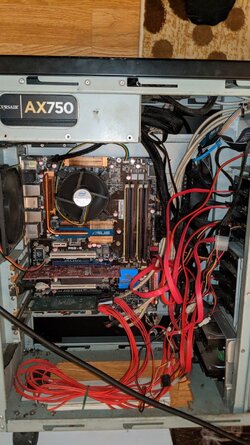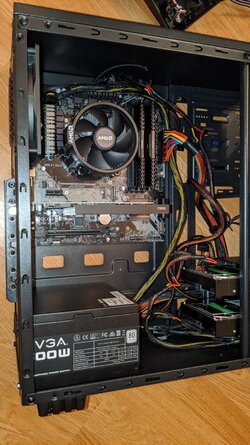Hello all!
After over 10 years, it's time to upgrade my media server/nas. Ten years is 4 lifetimes in technology world and I'm woefully out of touch, so hoping folks with more (recent) experiences might be able to provide some thoughts for my next build and setup. Requesting opinions on hardware, operating system and applications.
My current server (more of a nas than a server) is using an old intel 775 cpu/mobo and 10 drives (using a sas expander card) running WHS2011.
Scenarios to be covered with the new build (plus notes on my experience with the current build):
1) File Storage/Sharing (mostly movies, music and photos) - WHS2011 is/was fine for this (with drivepool).
2) Full Redundancy - WHS stunk for this but Stablebit Drivepool add-in makes it excellent.
3) FTP Server - WHS2011 also fine. Like that remote users get a nice browser interface.
4) Music/Movie Streaming (ala netflix, hulu, etc) to connected devices (couple smart tvs, pc's, tablets, phones) as well as from anywhere with an internet connection - My setup is horrible for this. No chance at smooth streaming. Only option is to copy the full file to the local device then play it.
5) Automated backups - WHS is/was excellent for this.
6) Great to have: Support live tv streaming and dvr of non-OTA in and outside the network using a cablecard tuner (silicondust hd homerun prime)
7) Fun to have: Support for things like Nest (have one of the intelligent thermostats), Echo Dot, Google Mini, maybe Sonos, etc
My current usage thoughts DO NOT include running VM's nor hosting applications.
Hardware:
Have lots of hardware laying around so, if possible, would like to use some of it. That said, if I need better equipment to meet my objecives, could budget some funds for purchases.
- cpu/mobo/ram- Have a couple setups laying around that MIGHT work. a) Ryzen 3 3200G, asrock pro4m, 16GB ddr4, and, b) Athlon II X2 250 (quad core), gigabyte ga-ma785gm with 8GB of (non-ECC) ddr3.
- vga- thinking of maybe using a 1080Ti that's not in use atm. Streaming is a high priority, would the 1080Ti be able to transcode maybe up to 3 streams at time?
- case- who cares, have a few
- 2x 8TB 7200 rpm sata drives
Is that 3200G sufficient? What's the story with ECC ram? Seems like most recommended media server builds call for 16-32GB of ECC ram. The server won't be running a lot of VM's or applications and the maximum number of simultaneous client connections is likely only 3 or 4 (but 2 would be the more normal usage). My only concerns with the 1080ti are heat and power. Would it be better to get a mid-range workstation card instead (like the quadro p2000)?
Also, am stil undecided (and looking for thoughts/opinions) on the operating system and other applications but recall reading that, if I use ZFS, it eats 1GB of ram for every terrabyte. If neither existing cpu/mobo/ram will likely meet my objectives, I'd welcome cpu/ram/mobo recommendations.
Operating system:
Definitely liked WHS2011 with the drivepool add-in. As a regular MS user it was familiar and easy. The ability to perform auto-backups of all connected machines was super easy.
Am totally open to using a different operating system but I'm not the most technically skilled person out here so it'd have to be easy. The ones showing up in searches include; WHS2011, Windows 10 (really??), Amahi, Ubuntu Server Edition, FreeNAS, ClearOS, OpenMediaVault and OpenFiler. The only ones I've experienced are WHS2011 and Win10 (but not as a server). Another question....as keys seem pretty cheap, would Windows Server 2016 or 2019 also be viable or totally useless given my needs?
Other apps:
It seems PLEX server is the go-to for streaming audio and video? What do you think? Seems I'd have to upgrade to the 'pro' version to get vga card transcoding working. Anyone used Serviio? Worth a look or just go with PLEX? Are there any other apps I should be thinking about for this build?
Tia for input and feedback!!!!
-Stefan
After over 10 years, it's time to upgrade my media server/nas. Ten years is 4 lifetimes in technology world and I'm woefully out of touch, so hoping folks with more (recent) experiences might be able to provide some thoughts for my next build and setup. Requesting opinions on hardware, operating system and applications.
My current server (more of a nas than a server) is using an old intel 775 cpu/mobo and 10 drives (using a sas expander card) running WHS2011.
Scenarios to be covered with the new build (plus notes on my experience with the current build):
1) File Storage/Sharing (mostly movies, music and photos) - WHS2011 is/was fine for this (with drivepool).
2) Full Redundancy - WHS stunk for this but Stablebit Drivepool add-in makes it excellent.
3) FTP Server - WHS2011 also fine. Like that remote users get a nice browser interface.
4) Music/Movie Streaming (ala netflix, hulu, etc) to connected devices (couple smart tvs, pc's, tablets, phones) as well as from anywhere with an internet connection - My setup is horrible for this. No chance at smooth streaming. Only option is to copy the full file to the local device then play it.
5) Automated backups - WHS is/was excellent for this.
6) Great to have: Support live tv streaming and dvr of non-OTA in and outside the network using a cablecard tuner (silicondust hd homerun prime)
7) Fun to have: Support for things like Nest (have one of the intelligent thermostats), Echo Dot, Google Mini, maybe Sonos, etc
My current usage thoughts DO NOT include running VM's nor hosting applications.
Hardware:
Have lots of hardware laying around so, if possible, would like to use some of it. That said, if I need better equipment to meet my objecives, could budget some funds for purchases.
- cpu/mobo/ram- Have a couple setups laying around that MIGHT work. a) Ryzen 3 3200G, asrock pro4m, 16GB ddr4, and, b) Athlon II X2 250 (quad core), gigabyte ga-ma785gm with 8GB of (non-ECC) ddr3.
- vga- thinking of maybe using a 1080Ti that's not in use atm. Streaming is a high priority, would the 1080Ti be able to transcode maybe up to 3 streams at time?
- case- who cares, have a few
- 2x 8TB 7200 rpm sata drives
Is that 3200G sufficient? What's the story with ECC ram? Seems like most recommended media server builds call for 16-32GB of ECC ram. The server won't be running a lot of VM's or applications and the maximum number of simultaneous client connections is likely only 3 or 4 (but 2 would be the more normal usage). My only concerns with the 1080ti are heat and power. Would it be better to get a mid-range workstation card instead (like the quadro p2000)?
Also, am stil undecided (and looking for thoughts/opinions) on the operating system and other applications but recall reading that, if I use ZFS, it eats 1GB of ram for every terrabyte. If neither existing cpu/mobo/ram will likely meet my objectives, I'd welcome cpu/ram/mobo recommendations.
Operating system:
Definitely liked WHS2011 with the drivepool add-in. As a regular MS user it was familiar and easy. The ability to perform auto-backups of all connected machines was super easy.
Am totally open to using a different operating system but I'm not the most technically skilled person out here so it'd have to be easy. The ones showing up in searches include; WHS2011, Windows 10 (really??), Amahi, Ubuntu Server Edition, FreeNAS, ClearOS, OpenMediaVault and OpenFiler. The only ones I've experienced are WHS2011 and Win10 (but not as a server). Another question....as keys seem pretty cheap, would Windows Server 2016 or 2019 also be viable or totally useless given my needs?
Other apps:
It seems PLEX server is the go-to for streaming audio and video? What do you think? Seems I'd have to upgrade to the 'pro' version to get vga card transcoding working. Anyone used Serviio? Worth a look or just go with PLEX? Are there any other apps I should be thinking about for this build?
Tia for input and feedback!!!!
-Stefan
Last edited:


